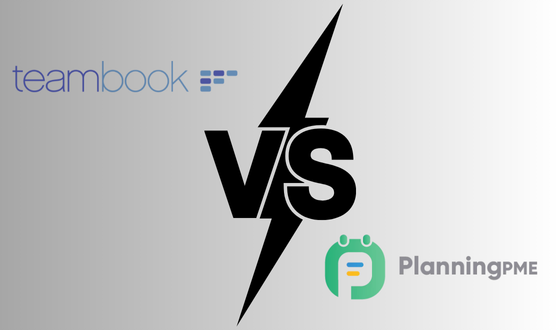Table of Contents
ToggleTeambook vs. Planning PME: what are the differences?
In a working environment increasingly focused on efficiency and productivity, project and team managers are constantly looking for high-performance tools to help them manage their projects and resources.
Of the many solutions available on the market, Teambook and Planning PME stand out for their functionality and popularity.
This article offers a detailed comparison of these two tools to help you choose the one that best meets your project management needs.
Teambook VS. Planning PME: which one to choose?
Teambook
Teambook is an innovative resource management solution that provides clear visibility of task allocation and team workloads. Developed to meet the needs of modern businesses, Teambook enables real-time planning and efficient project management.
What’s more, Teambook is an excellent tool for managing skills over the medium term (6-24 months). This gives you an idea of how your plans will affect the business in the short and long term and also gives you an idea of whether you have enough work in progress.
Finally, Teambook can be integrated with Zapier, Jira and Slack to make it easier to exchange and synchronise data between different platforms. It also has extensive integrations with various tools and robust APIs for custom integrations. If you’re already working on another tool of this type (Smartsheet or another), migrating all your data to Teambook is very easy. We have everything you need to migrate your data without losing any information.
In short, Teambook gives you a clear view of resource usage and enables you to maximise the efficiency of your project teams.
Target users
- Small and medium-sized enterprises (SMEs) managing multiple projects and resources.
- For example, creative agencies and marketing teams, or software development teams.
- Organisations requiring simple and effective resource management.
Teambook is available in most European languages (French, English, German, Italian and Spanish). So is the support. It’s a tool designed in Switzerland, unlike most of its British or American competitors. Finally, the data is stored in Europe.
Price
- Free 30-day trial.
- Starter offer at $3 per month for planning up to 10 projects to get you started.
- Pro plans start at $45 per month for 40 projects, unlimited users.
Planning PME
Planning PME is a robust tool designed for small and medium-sized businesses. It offers comprehensive resource planning and scheduling capabilities, enabling managers to track and adjust resource allocations in real time for optimal project management.
Target users
Planning PME is primarily intended for small and medium-sized enterprises (SMEs) looking to improve their resource management and project planning.
Prices
Planning PME offers 2 products: a « Software » version and a Web version.
- Software version: 490 euros excluding VAT (1st licence, one-off payment)
- Web version
- :Standard: €5 (excl. VAT) per resource/monthPremium
- : €6.22 (excl. VAT) per resource/monthEnterprise
- : €7.56 (excl. VAT) per resource/month.
Teambook VS Planning PME: comparison of features
Resource management
- Teambook: with Teambook, project managers can easily assign resources to different tasks and get instant visibility of each team member’s workload. Real-time reporting features help to optimise the use of resources.
- Planning PME: Planning PME stands out for its ability to adjust schedules and resources in real time, enabling proactive and reactive project management.
User interface
- Teambook: Teambook’s interface is renowned for being intuitive and easy to use. It enables fast, fluid navigation between the various functions.
- Planning PME: Although robust, Planning PME’s interface may seem complex to new users, but offers a high degree of customisation for advanced users.
Integrations and compatibility
- Teambook: Teambook offers numerous integrations with other project management tools and professional software, making it easy to adopt in existing work environments.
- Planning PME: Planning PME is compatible with numerous systems and offers integrations tailored to the needs of small and medium-sized businesses.
Support and training
- Teambook: Teambook offers responsive customer support and comprehensive training resources to help users get the most out of the tool.
- Planning PME: Planning PME also offers efficient technical support, accompanied by detailed documentation and tutorials.
Teambook VS Planning PME: advantages and disadvantages
Teambook
- Benefits: Teambook stands out for its flexibility and responsiveness, as well as its modern, user-friendly interface. It is particularly appreciated for its ability to adapt to changing project needs.
- Disadvantages: The cost of Teambook may be an obstacle for some companies, and certain advanced functions may require time to learn.
Planning PME
- Benefits: Planning PME is appreciated for its robustness and adaptability to various business sectors. It enables efficient management of schedules and resources.
- Disadvantages: Its interface can be perceived as complex and offers fewer customisation options than Teambook.
Conclusion: why choose Teambook over Planning PME?
In summary, Teambook and Planning PME are two powerful project management tools, each offering distinct advantages. The choice between these two solutions will depend on your company’s specific needs. If you’re looking for flexibility and a modern interface, Teambook could be the ideal tool. On the other hand, if you’re looking for a robust, adaptable solution, Planning PME might be better suited to your needs.



